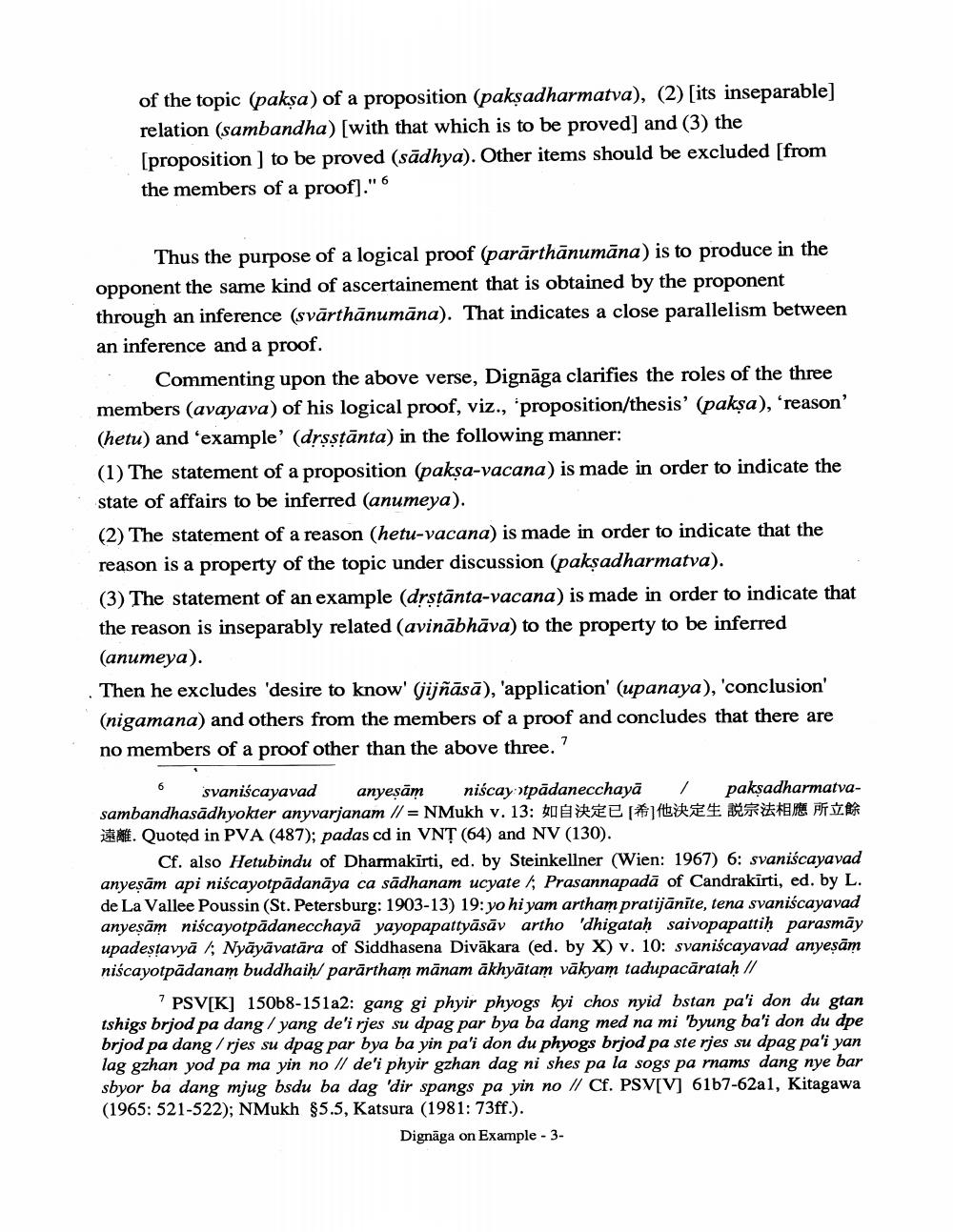Book Title: Role Of Drstanta Indignagas Logic Author(s): Shoryu Katsura Publisher: Shoryu Katsura View full book textPage 3
________________ of the topic (paksa) of a proposition (pakṣadharmatva), (2) [its inseparable] relation (sambandha) [with that which is to be proved] and (3) the [proposition] to be proved (sädhya). Other items should be excluded [from the members of a proof]." Thus the purpose of a logical proof (parärthänumāna) is to produce in the opponent the same kind of ascertainement that is obtained by the proponent through an inference (svärthänumāna). That indicates a close parallelism between an inference and a proof. Commenting upon the above verse, Dignaga clarifies the roles of the three members (avayava) of his logical proof, viz., 'proposition/thesis' (paksa), 'reason' (hetu) and 'example' (drṣṣtänta) in the following manner: (1) The statement of a proposition (pakṣa-vacana) is made in order to indicate the state of affairs to be inferred (anumeya). (2) The statement of a reason (hetu-vacana) is made in order to indicate that the reason is a property of the topic under discussion (pakṣadharmatva). (3) The statement of an example (drstänta-vacana) is made in order to indicate that the reason is inseparably related (avinābhäva) to the property to be inferred (anumeya). Then he excludes 'desire to know' (jijñāsā), 'application' (upanaya), 'conclusion' (nigamana) and others from the members of a proof and concludes that there are no members of a proof other than the above three. svaniscayavad anyesām niścay spädanecchaya sambandhasadhyokter anyvarjanam // = NMukh v. 13: [] . Quoted in PVA (487); padas cd in VNT (64) and NV (130). / pakṣadharmatva Cf. also Hetubindu of Dharmakirti, ed. by Steinkellner (Wien: 1967) 6: svaniscayavad anyeşām api niścayotpädanaya ca sadhanam ucyate / Prasannapada of Candrakirti, ed. by L. de La Vallee Poussin (St. Petersburg: 1903-13) 19: yo hiyam artham pratijānīte, tena svaniscayavad anyeṣām niścayotpadanecchaya yayopapattyäsäv artho 'dhigatah salvopapattiḥ parasmay upadestavya Nyäyävatära of Siddhasena Diväkara (ed. by X) v. 10: svaniscayavad anyesam niścayotpadanam buddhaiḥ/ parärtham manam äkhyātam vākyam tadupacarataḥ // 7 PSV[K] 150b8-151a2: gang gi phyir phyogs kyi chos nyid bstan pa'i don du gtan tshigs brjod pa dang/yang de'i rjes su dpag par bya ba dang med na mi byung ba'i don du dpe brjod pa dang/rjes su dpag par bya ba yin pa'i don du phyogs brjod pa ste rjes su dpag pa'i yan lag gzhan yod pa ma yin no // de'i phyir gzhan dag ni shes pa la sogs pa rnams dang nye bar sbyor ba dang mjug bsdu ba dag 'dir spangs pa yin no // Cf. PSV[V] 61b7-62a1, Kitagawa (1965: 521-522); NMukh §5.5, Katsura (1981: 73ff.). Dignaga on Example - 3Page Navigation
1 2 3 4 5 6 7 8 9 10 11 12 13 14 15 16 17 18 19 20 21 22 23 24
